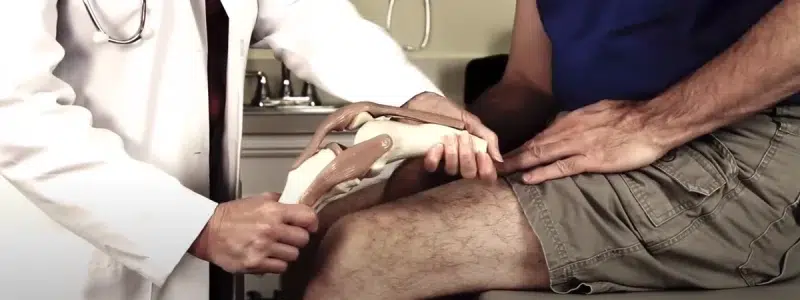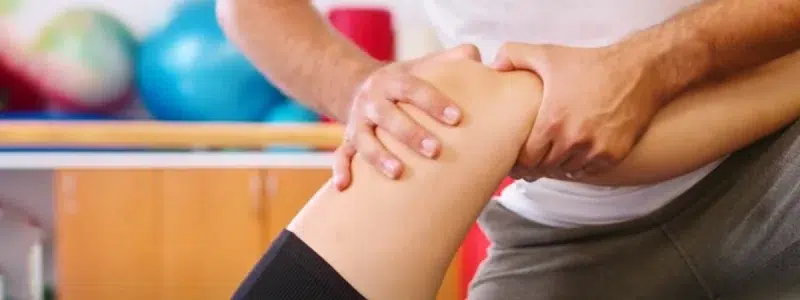The most experienced cyclists can get injured, especially with meniscus tears. This injury can cause a variety of effects on a person, both physical and mental. When a meniscus tear occurs, it can lead to knee pain, swelling, and stiffness and can cause a decline in a person’s overall well-being. So, taking preventative measures to avoid a meniscus tear should always be a top priority.
Yes. Cycling can cause a meniscus tear, especially from an impact or lateral bend. Those with a defective meniscus should be cautious when cycling.
In this blog post, we will explore meniscus tears caused by cycling, all the reasons, the risks, and complications associated with cycling meniscus tears, and prevention tips for meniscus tears caused by cycling.
Meniscus Tear Caused By Cycling: 6 Dangers You Missed

Meniscus occurs when a cyclist rides for extended periods without adequate rest intervals, leading to increased stress on the knee joint. Here are some common reasons cyclists tear their meniscus:
- Overuse and Repetition: Overusing and putting repetitive stress on the knee joint while cycling can cause meniscus tears. This is especially true for cyclists who spend long hours on their bikes, leading to muscle fatigue, which can cause a lack of stability in the knee joint.
- Saddle Positioning: The position of your saddle can cause or worsen a meniscus tear. A saddle that is too high or too low can make your knee move unnaturally, putting extra strain on the meniscus, eventually resulting in a rip.
- Foot Placement: Foot placement on your bike can also contribute to meniscus tears. Having your foot too far forward or backward can alter your knee’s alignment, putting extra stress on the meniscus.
- Incorrect Bike Fit and Positioning: Cycling with the wrong bike fit and improper positioning can unnecessarily pressure the meniscus and cause it to tear. Foot positioning, saddle height, and handlebar reach are significant factors that need to be appropriately adjusted for cycling to minimize the risk of injury.
- Sudden Trauma and Accidents: Any sudden impact or accident while cycling can cause trauma, leading to meniscus tears. Sudden falls, collisions, and overuse of the breaks can lead to severe injuries.
- Poor Riding Technique: Cycling with poor riding technique can cause meniscus tears. Incorrect pedaling methods, such as pushing down too hard on the pedals and improper posture and body alignment, can cause unnecessary stress on the knee joint.
- Age-Related Wear and Tear: Our bodies naturally undergo wear and tear with age. The meniscus can undergo degeneration and wear down, thus increasing the possibility of a tear.
6 Complications and Risks of Cycling Meniscus Tears
Cycling can also lead to injuries, including meniscus tears. A torn meniscus can lead to a feeling of your knee giving way, inability to move your knee as usual, or persistent knee pain. You might be more likely to develop osteoarthritis in the injured knee. Here are some difficulties and dangers that you should know:
Knee Pain and Swelling
You may experience knee pain and swelling from a torn meniscus. The location of the tear and damage to the knee’s structure can cause this. There can be enough swelling to restrict your movement and daily activities.
Limited Knee Flexibility
A meniscus tear can limit the knee’s flexibility and restrict your range of motion. This can cause discomfort, especially when you bend or straighten your knee. You may also feel a clicking sensation when moving your knee, which can be painful and frustrating.
Knee Instability
A meniscus tear can cause knee instability, leading to balance problems and falls. This is especially true when cycling at high speeds or on uneven surfaces. Knee instability can cause further damage, prolonging your recovery time.
Arthritis
If you do not get proper treatment for a meniscus tear, it can lead to arthritis. A meniscus tear can cause the bones in your legs to rub against each other, causing pain and inflammation. Over time, this can develop into arthritis, a chronic and debilitating condition.
Muscle Weakness
When you have a meniscus tear, it can cause muscle weakness in your legs. The pain and swelling can prevent you from exercising and performing other activities. Muscle weakness can lead to further complications and increase your recovery time.
Increased Risk of Future Knee Injuries
If you have a meniscus tear, you’re more susceptible to future knee injuries. A damaged meniscus can lead to knee instability, increasing the risk of other knee injuries, such as anterior cruciate ligament tears. These injuries can cause more significant complications and take longer to heal.
7 Helpful Prevention Tips For Meniscus Tears While Cycling

Cycling can be an excellent cross-training option if you have a meniscus tear, but it will only suit some. If your knee feels uncomfortable, check whether it makes a difference if you adjust your saddle higher is often better. Here are some valuable tips to keep in mind while cycling:
- Strengthen Your Leg Muscles: Strengthening your leg muscles, such as glutes, quads, and hamstrings, can help prevent meniscus tears. Incorporate strength training exercises into your cycling routine to improve leg strength and endurance.
- Warm Up Before Riding: Before cycling, it is critical to warm up your muscles and joints to prevent sudden trauma and accidents. Do some stretches, such as hamstring and calf stretches, and take a few minutes to do some light cycling to loosen up your leg muscles.
- Get a Professional Bike Fit: To avoid the risk of overuse and repetition, it is essential to have proper bike fit and positioning. A professional bike fit can optimize your posture, reduce knee strain, and help prevent meniscus tears.
- Use Proper Riding Technique: Poor riding technique can strain your knees excessively, leading to meniscus tears. Maintain a smooth pedaling motion and avoid excessive knee bend and torque. Use your glutes and quads to help power your cycling.
- Wear Proper Footwear: Proper footwear can also help prevent meniscus tears. Choose to cycle shoes that provide good traction and support, and ensure your cleats are correctly positioned on your pedals.
- Slowly Increase Cycling Intensity: Increasing your cycling intensity too quickly can lead to overuse injuries, including meniscus tears. Gradually build up your mileage and intensity to prevent sudden knee trauma.
- Take breaks when needed: If you feel discomfort or pain in your knee joint while cycling, taking a break and rest is essential. Continuing to cycle through pain can make the condition worse and lead to a more extended recovery period. Always listen to your body and take breaks as needed.
Meniscus Tears Caused By Cycling: 4 Effective Treatments
Meniscus tears are a common injury among cyclists. The constant pedaling motion and sudden stops put a lot of pressure on the knee joint, which can cause meniscus tears. There are several treatment options available for cycling-related meniscus tears.
Conservative Treatments
Conservative treatments are the most common treatment option that is available to people who suffer from meniscus tears because of cycling. These treatments include:
- Rest: Giving your knee time to rest and heal is essential. Do not engage in any activities that cause pain or discomfort to your body.
- A pleasant way to reduce swelling and pain in an affected area is to apply ice to it. Apply ice for 15-20 minutes several times a day.
- Medication: Over-the-counter pain relievers like ibuprofen can help relieve pain and reduce inflammation.
Physical Therapy
Physical therapy can be a helpful method for treating meniscus tears caused by cycling. A physical therapist can help you:
- Improve range of motion: With physical therapy, you can regain your knee’s full range of motion.
- Strengthen muscles: Strengthening the muscles surrounding your knee is an excellent way to help support it and reduce the risk of future injuries from occurring.
- Reduce pain: Physical therapy techniques like
- ultrasound or electrostimulation can aid in the reduction of pain and inflammation as well.
Surgery
A severe case of cycling injuries may require surgery to repair the injuries because of cycling. Surgery options include:
- Meniscectomy: This procedure involves the removal of the damaged part of the meniscus.
- Meniscus repair: The torn meniscus is sewn back together.
- Meniscus replacement: The damaged meniscus is replaced with a synthetic one.
Long-Term Management

Long-term management is essential for preventing future injuries. This includes:
- Wearing protective gear: Knee pads or braces can provide extra support and help prevent injuries.
- Maintaining a healthy weight: Excess weight puts a lot of pressure on your knee joint, increasing the risk of meniscus tears.
- Strengthening muscles: Strengthening the muscles around your knee can reduce the risk of future injury by supporting the joint.
Conclusion
In conclusion, meniscus tears, a painful cycling injury, can be prevented by understanding and mitigating risk factors. Prioritizing knee health and seeking immediate treatment can enhance meniscus health.
If knee discomfort occurs while cycling, it’s crucial to address it promptly. Consultation with a healthcare professional or physiotherapist can prevent further damage. By taking care of your knees, you can continue to enjoy the benefits of cycling while minimizing the risk of knee injuries.
FAQs
What Are The Symptoms of a Meniscus Tear Caused By Cycling?
Common meniscus tears caused by cycling include pain, swelling, stiffness, clicking or popping sensations in the knee joint, limited range of motion, and difficulty bearing weight on the affected leg. It is essential to seek medical attention if these symptoms persist or worsen.
Is Cycling Good For Meniscus Tear?
Low-impact exercises, such as stationary biking, can reduce pain, improve mobility, and restore function to the area around the meniscus tear. As your knee and muscles strengthen, your physical therapist will guide you to more vigorous activity.
Can I Still Cycle With A Meniscus Tear?
It depends on the severity of the injury, as well as the advice of your doctor. Sometimes, your doctor may advise you to take a break from cycling to allow time for your knee to heal.

![The 7 Reasons for Meniscus Tears Caused by Cycling & 7 Prevention Tips [Helpful]](https://cacyclinghub.com/wp-content/uploads/2024/02/Meniscus-Tear-Caused-By-Cycling.jpg)
